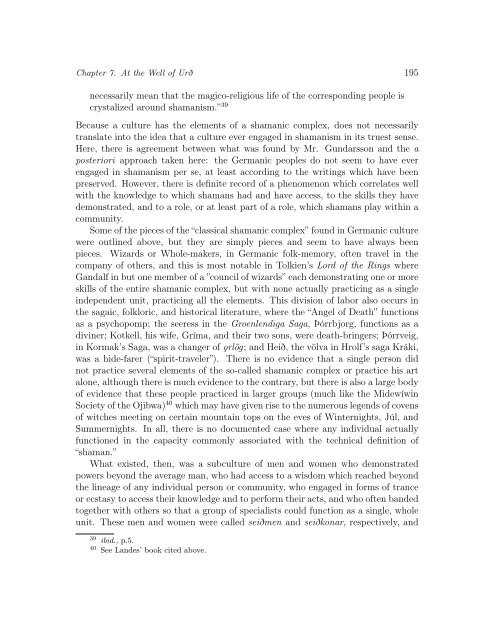Untitled - Awaken Video
Untitled - Awaken Video
Untitled - Awaken Video
You also want an ePaper? Increase the reach of your titles
YUMPU automatically turns print PDFs into web optimized ePapers that Google loves.
Chapter 7. At the Well of Urð 195<br />
necessarily mean that the magico-religious life of the corresponding people is<br />
crystalized around shamanism.” 39<br />
Because a culture has the elements of a shamanic complex, does not necessarily<br />
translate into the idea that a culture ever engaged in shamanism in its truest sense.<br />
Here, there is agreement between what was found by Mr. Gundarsson and the a<br />
posteriori approach taken here: the Germanic peoples do not seem to have ever<br />
engaged in shamanism per se, at least according to the writings which have been<br />
preserved. However, there is definite record of a phenomenon which correlates well<br />
with the knowledge to which shamans had and have access, to the skills they have<br />
demonstrated, and to a role, or at least part of a role, which shamans play within a<br />
community.<br />
Some of the pieces of the “classical shamanic complex” found in Germanic culture<br />
were outlined above, but they are simply pieces and seem to have always been<br />
pieces. Wizards or Whole-makers, in Germanic folk-memory, often travel in the<br />
company of others, and this is most notable in Tolkien’s Lord of the Rings where<br />
Gandalf in but one member of a ”council of wizards” each demonstrating one or more<br />
skills of the entire shamanic complex, but with none actually practicing as a single<br />
independent unit, practicing all the elements. This division of labor also occurs in<br />
the sagaic, folkloric, and historical literature, where the “Angel of Death” functions<br />
as a psychopomp; the seeress in the Groenlendiga Saga, Þórrbjorg, functions as a<br />
diviner; Kotkell, his wife, Gríma, and their two sons, were death-bringers; Þórrveig,<br />
in Kormak’s Saga, was a changer of ¸orlög; and Heið, the völva in Hrolf’s saga Kráki,<br />
was a hide-farer (“spirit-traveler”). There is no evidence that a single person did<br />
not practice several elements of the so-called shamanic complex or practice his art<br />
alone, although there is much evidence to the contrary, but there is also a large body<br />
of evidence that these people practiced in larger groups (much like the Midewíwin<br />
Society of the Ojibwa) 40 which may have given rise to the numerous legends of covens<br />
of witches meeting on certain mountain tops on the eves of Winternights, Júl, and<br />
Summernights. In all, there is no documented case where any individual actually<br />
functioned in the capacity commonly associated with the technical definition of<br />
“shaman.”<br />
What existed, then, was a subculture of men and women who demonstrated<br />
powers beyond the average man, who had access to a wisdom which reached beyond<br />
the lineage of any individual person or community, who engaged in forms of trance<br />
or ecstasy to access their knowledge and to perform their acts, and who often banded<br />
together with others so that a group of specialists could function as a single, whole<br />
unit. These men and women were called seiðmen and seiðkonar, respectively, and<br />
39 ibid., p.5.<br />
40 See Landes’ book cited above.
















